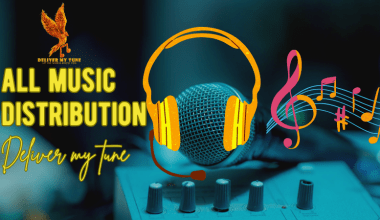In the current digital landscape, music distribution for labels has evolved from pressing records and selling CDs to leveraging online platforms and streaming services. Digital distribution has made it easier for labels to reach global audiences, but it also requires a modern approach to succeed. This detailed guide explores how labels can optimize their distribution processes, select the right platforms, and maximize revenue for their artists.
Whether you are a small independent label or a large established entity, this guide will help you navigate music distribution’s complexities and opportunities, ensuring that your artists’ music reaches the widest possible audience and garners the attention it deserves.
What is Music Distribution for Labels?
Music distribution for labels is the process that allows record labels to share their artists’ music across various platforms, reaching listeners worldwide. This is achieved through digital distribution services that make music available on streaming services, digital stores, and other online outlets. While distribution once involved physical media, digital distribution is now the primary method, making it easier to reach audiences with fewer costs.
For labels, the goal is to ensure that music is accessible, discoverable, and monetized across as many channels as possible. With platforms like Spotify, Apple Music, and YouTube Music dominating the market, successful distribution requires understanding each platform’s unique features and requirements.
Why Music Distribution is Essential for Labels
The importance of music distribution for labels cannot be overstated. Digital distribution brings several advantages that benefit both labels and artists, such as:
- Increased Reach and Global Presence: Through digital platforms, music can reach audiences far beyond the label’s local markets, creating opportunities to grow fan bases internationally.
- Diverse Revenue Streams: Digital distribution provides royalties from streaming, downloads, and even licensing opportunities, which combine to create a sustainable revenue model.
- Detailed Listener Insights: Many platforms provide in-depth analytics on listener demographics, enabling labels to tailor marketing strategies more effectively.
- Efficient Promotion: Digital distribution allows labels to time releases strategically and target fans directly, enhancing promotional efforts and ensuring music gets noticed.
Music distribution isn’t just about getting songs onto platforms; it’s about maximizing the potential for each release to reach as many listeners as possible and convert those listeners into loyal fans.
Types of Music Distribution Channels
Labels can distribute music through multiple channels, each providing a unique way to reach audiences. Here are the most common channels:
- Physical Distribution: Although digital has overtaken physical media, CDs and vinyl still have a place in niche markets.
- Digital Streaming Services (DSPs): Platforms like Spotify, Apple Music, and Amazon Music allow listeners to stream music on demand.
- Social Media Platforms: Social media sites like Instagram, Facebook, and TikTok let labels promote music and engage fans directly.
- Video Streaming Platforms: YouTube and other video sites are excellent for building a visual brand alongside music releases, allowing fans to connect with artists visually.
Combining these channels ensures that music is accessible across different audience groups, helping labels reach more listeners and drive engagement.
Popular Digital Distribution Platforms for Labels
Understanding which platforms to prioritize is crucial for effective music distribution for labels. Here are some of the most popular and impactful platforms:
- Spotify: As one of the biggest streaming platforms, Spotify allows labels to reach millions of listeners globally. Labels can manage artist profiles, gain insights into fan behavior, and create pre-save campaigns to build momentum before releases.
- Apple Music: Apple Music offers high-quality streaming, curated playlists, and artist profiles, making it a valuable platform for connecting with fans.
- YouTube Music: With both music and video streaming capabilities, YouTube Music is ideal for labels looking to strengthen their visual presence alongside their audio catalog.
- Amazon Music and Deezer: These platforms, though smaller than Spotify and Apple Music, offer substantial audiences and unique marketing opportunities.
- TikTok: While primarily a social media app, TikTok is increasingly becoming a discovery platform for new music, making it an essential channel for promoting singles.
Using these platforms together helps labels to reach diverse audiences, and partnering with a distributor that covers most or all of these services will amplify each release’s reach.
Best Practices in Music Distribution for Labels
Maximizing success in music distribution for labels requires more than simply uploading songs. Here are best practices to help labels make the most of their efforts:
- Schedule Releases Strategically: Consider timing releases around major events or seasons to capture listener attention.
- Create Playlists and Seek Playlist Placement: Playlists are an essential part of digital streaming. Labels should create their own playlists and collaborate with playlist curators for more visibility.
- Engage in Pre-Save Campaigns: Pre-save campaigns, especially on Spotify, let fans save songs before release, increasing engagement on release day.
- Optimize Metadata and Cover Art: Proper metadata (like genre tags and artist information) helps algorithms recommend the music to the right audiences.
- Collaborate with Influencers and Artists: Collaborations and partnerships with influencers and other artists expand reach and attract new listeners.
Following these practices ensures that each release is positioned for optimal success across streaming platforms, social media, and fan engagement strategies.
Challenges in Music Distribution
While digital distribution offers significant benefits, labels face several challenges that can impact distribution effectiveness:
- Competitive Playlists: Gaining playlist placements is highly competitive, making it challenging for new labels to stand out.
- Royalties and Revenue Splits: Digital platforms often pay out low royalties per stream, requiring labels to generate high streaming volumes for substantial income.
- Content Management: Managing large catalogs and ensuring correct metadata can be time-consuming and complex.
- Data Overload: Platforms offer massive amounts of data, but understanding and using it effectively for marketing can be challenging for labels.
Understanding these challenges and proactively planning solutions, such as by using analytics tools or engaging with experienced distributors, can help labels overcome common obstacles.
Maximizing Revenue through Music Distribution
For labels, maximizing revenue through distribution means making the most of each song’s earning potential. Here’s how to do it:
- Leverage Multiple Platforms: The more places music is available, the greater its reach and revenue potential.
- Use Targeted Marketing and Advertising: Run targeted ads on social media and search engines to drive listeners to streaming platforms.
- Engage in Sync Licensing: Licensing music for films, ads, and TV shows provides an additional revenue stream beyond streaming.
- Create a Brand Identity: Building a strong brand around the label helps attract listeners who resonate with the artists and genres.
- Utilize Analytics for Decision-Making: Use insights from platforms to understand audience preferences, guiding future marketing and release decisions.
Taking these actions helps labels create a diversified and resilient revenue model, ensuring they’re not dependent solely on streaming.
Frequently Asked Questions (FAQs)
Q1: How does music distribution generate royalties?
Royalties from streaming platforms are paid based on a percentage of the revenue generated by streams or downloads. Labels receive royalties through their distributor, who collects payments from digital service providers.
Q2: What should a label look for in a distribution partner?
Choose a distributor with access to major platforms, favorable revenue splits, good support, and effective tools for promoting music. Also, ensure the distributor aligns with the label’s goals and target market.
Q3: How do playlists impact music distribution success?
Playlists are critical for exposure, as they help new listeners discover music. Getting placed on popular playlists can drive large volumes of streams, which directly affects royalties and fan engagement.
Q4: Can independent labels distribute music without a distribution partner?
Technically, yes, but using a partner simplifies the process, handles royalty collections, and offers greater support. A distribution partner can also provide guidance on marketing and playlist pitching.
Q5: How can labels track the success of their music distribution?
Platforms like Spotify for Artists, Apple Music for Artists, and YouTube Analytics provide valuable data on streams, listener demographics, and engagement rates. Regularly reviewing these insights can help labels understand performance and adjust strategies as needed.
Conclusion
Music distribution for labels has transformed from a complex, physical process to an accessible, digital-first approach that provides more control, revenue opportunities, and audience reach. Labels that embrace digital distribution can build a sustainable business model, grow their audience base, and maximize the impact of their releases.
From choosing the right platforms to strategically marketing each release, this guide provides the foundation for mastering digital distribution. Labels can now reach global audiences, analyze their listening data, and grow fan loyalty more effectively than ever before. By understanding and leveraging the tools and strategies outlined here, labels can optimize their distribution efforts, maximize revenue, and establish a strong digital presence for their artists in a competitive music landscape.
In the evolving world of music distribution, staying informed and adaptable is essential. As new trends and technologies emerge, labels that remain proactive will find the most success, ensuring that they—and their artists—flourish in an increasingly digital music industry.
Related Articles:
For further reading, explore these related articles:
- JioSaavn vs Gaana for Artists: Which is Better for Your Music Career?
- Comprehensive Guide to JioSaavn Music Distribution for Independent Artists
- Promoting Music on JioSaavn: A Complete Guide for Independent Artists
For additional resources on music marketing and distribution, visit Deliver My Tune.






